
CRAIG HOSPITAL FOUNDATION FALL 2024 IMPACT REPORT



CRAIG HOSPITAL FOUNDATION FALL 2024 IMPACT REPORT

For many people, work is a significant part of their lives. In addition to earning an income, employment allows individuals to develop a sense of identity and pride, establishes important social connections, and increases self-esteem and independence.
For 45-year-old Alan Payne, teaching art at Annunciation Catholic School in Northeast Denver provided him with a sense of meaning and purpose. Not only did he find pleasure in providing for his family, but teaching art also meant helping young students find joy and creativity—something he loved.
It’s also a calling that Alan is desperately trying to get back to since his life-altering accident more than two years ago.
After finishing work on Thursday, December 16, 2021, Alan, an experienced cyclist, was enjoying a ride on a warm, winter afternoon when a truck suddenly turned in front of his bike, causing him to T-bone the truck.
He was rushed to a nearby Level 1 Trauma Center, where he was diagnosed with a diffuse axonal brain injury and placed in a medically induced coma.
Shortly after, Alan was transferred to Craig Hospital, where he spent the next three months surrounded by
his wife, Meg, and his infant son, Silas, who was born just a few weeks after the accident.
“I knew Craig Hospital was the best place for Alan,” recalls Meg, a physical therapist who had worked at Craig back in 2013. “We both feel very blessed to live in a city with a world-renowned rehab hospital.”
While at Craig, Alan slowly began the recovery process. “I don’t remember most of my time at Craig,” says Alan. “I had no memory of the accident, and I couldn’t feed myself or shower on my own. I also had global aphasia and severe motor planning deficits. My days were spent in physical, occupational, and speech therapy, trying to regain so many lost skills.”
In late March, Alan was discharged from inpatient and returned to Craig twice a week for outpatient therapy.
It was during Alan’s outpatient treatment in October 2022 that he began working with Casey Pfister, an occupational therapy specialist with the donorsupported Community Reintegration program.
“Our main objective is to help patients return to productive, community-based activities, such as work or school,” Casey explains. “We concentrate on each patient’s unique objectives in order to achieve a sense
of stability, meaning, and enjoyment. In some cases, it’s a big piece of our identity, so helping patients return to that role is our main focus.”
She adds, “Depending on a patient’s specific needs and goals, our services include work readiness assessments, collaboration with employers, coaching and development, career planning, and community resource connection.”
While getting back to teaching on a full-time basis was Alan’s long-term goal, he knew he wasn’t ready. “I set a date of August 2025 as my target for getting back in the classroom full-time,” he explains. “I still had many challenges, and I knew I had a lot of work to do before then. Casey helped me break down milestones to support timelines and progress for my long-term goal.”
Casey’s first step was to get Alan involved in volunteering to give him a sense of purpose and increase his productivity. She helped vet volunteer sites by assessing environments, duties, interests, current abilities, and barriers. In addition, she connected him with a reliable, affordable transportation option.
Based on his interests and passions, she set up volunteering opportunities at Bikes Together—a nonprofit bike shop and community hub for equitable bike access and education—and in the art room at C3, a Denver elementary school.
“Volunteering provided a great opportunity for Alan to build self-advocacy skills, practice collaboration and communication with his supervisors and co-workers, develop checklists and strategies to compensate for memory challenges, and improve independence,” Casey explains.
“At the same time, we worked together on goal mapping, role-played scenarios that might take place in the workplace, and developed strategies to address Alan’s fatigue and limitations related to memory, planning, and organization,” she says. “We also reinforced routines by using a day planner, reminders, and alarms.”
Casey also met with Alan’s supervisors to discuss accommodations, performed onsite visits to analyze work demands and observed Alan at work to help boost his performance.
“The goal was to help Alan incorporate strategies and establish routines in the context of volunteering and work,” Casey explains. “The beauty of our program is that it allows us to have more of an impact by going into the environment and making impactful changes.”
When Alan was ready, a part-time job was the next step. Prior to his accident, he worked at Molly’s Spirits, a large, liquor store in Denver, so Casey reached out
to his previous supervisor and arranged for Alan to return to Molly’s Spirits about 12 hours a week with accommodations.
Casey also connected Alan with the Division of Vocational Rehabilitation and a benefits counselor, which was critical to Alan’s understanding of how his work earnings impact benefits.
In addition to supporting Alan in his work at the liquor store, Casey is currently helping him boost his confidence and increase his responsibilities at C3, including teaching more art lessons in the classroom. “I benefit from practice and repetition, so I’m working on developing a lesson plan to teach print-making to first graders,” Alan explains. “And Casey plans to organize a rehearsal in front of Craig staff before I deliver the lesson to my students.”
He adds, “Casey has set me up for success, and I feel so grateful. She’s taught me how to advocate for myself, develop a problem-solving mindset, tolerate longer days, and get my confidence back. I am even driving again, which is something I never thought was possible. But thanks to the support of Natalie Uyeno [a driving rehab specialist in Craig’s donor-supported Adaptive Driving Program], I am back on the road again and can independently drive myself and access the community.”
When Casey reflects on her time working with Alan since 2022, she can’t help but smile. “Alan is an amazing example of what’s possible after a brain injury. He works so hard and has the best attitude. People may not realize that a brain injury is forever. Alan will face challenges every day for the rest of his life, but through it all, he stays positive, is always open to feedback, and focuses on growth and self-improvement. He’s quite amazing and an inspiration to so many.”
Thanks to the generosity of donors, Alan has been able to return to work and access his community through Craig’s Community Reintegration and Adaptive Driving Programs. To learn more about patients like Alan, please visit craighospital.org/blog

On March 30, 2023, 20-year-old Nate Acunto was driving to work in Emery, South Dakota, when he was involved in a serious car accident. He was rushed to a local hospital and then airlifted to another hospital that could manage his life-threatening injuries.
Nate immediately underwent an occipital-cervical fusion procedure to fuse his skull and spine, and was diagnosed with a C1 complete spinal cord injury.
Nate’s parents knew about Craig Hospital and believed it was the best place for their son’s rehabilitation. While several wounds originally delayed Nate’s transfer to Craig, he medically stabilized after several days and was able to fly to Denver in late April.
“Being at Craig was a great experience during a very difficult time,” Acunto explains. “I participated in physical therapy, occupational therapy and speech therapy, and took part in recreational therapy outings. I was unable to talk for the first half of my rehab, but it was still nice to spend time in the Teen Rehab at Craig (TRAC) Program with other people my age.”
He adds, “And while I focused on my rehab, my parents spent a lot of time learning how to take care of me, so my return home would be successful.”
When it was time to start preparing to return to South Dakota, the Craig team began suggesting equipment that Nate would need at home. But the equipment was extremely expensive and the family’s insurance did not cover a majority of it.
“While it was clear to us and to Nate’s care team that these devices were vital for Nate, our insurance company did not agree,” explains Sarah Renberg, Nate’s mother.
And that’s where the Craig Hospital Foundation came into play.
Thanks to two donor-sponsored, patient assistance funds — the Assistive Technology Patient Assistance Fund and the SCI Scholars Fund — Nate received all the equipment he needed at home. This included a Tobii Dynavox eye tracker, a QuadStick game controller, Dragon software and microphone, and an attendant call switch and phone mount.
“There’s no way we could have managed to purchase all of this equipment without Craig’s help. It’s been an absolute lifesaver for us,” adds Sarah.
Established in 2016 by the Brotman family, who experienced Craig firsthand, the SCI Scholars Fund provides adaptive technology and tools to support the educational pursuits of patients with spinal cord injuries. In addition, the Assistive Technology Patient Assistance Fund provides adaptive tech equipment scholarships to patients with financial need.
Craig also helped support Nate’s family with their home renovations. “Without financial assistance, we would have struggled to adapt our home for Nate’s wheelchair,” Sarah says. “It has been an overwhelming experience, but Craig has helped us every step of the way. We are so appreciative of their support.”

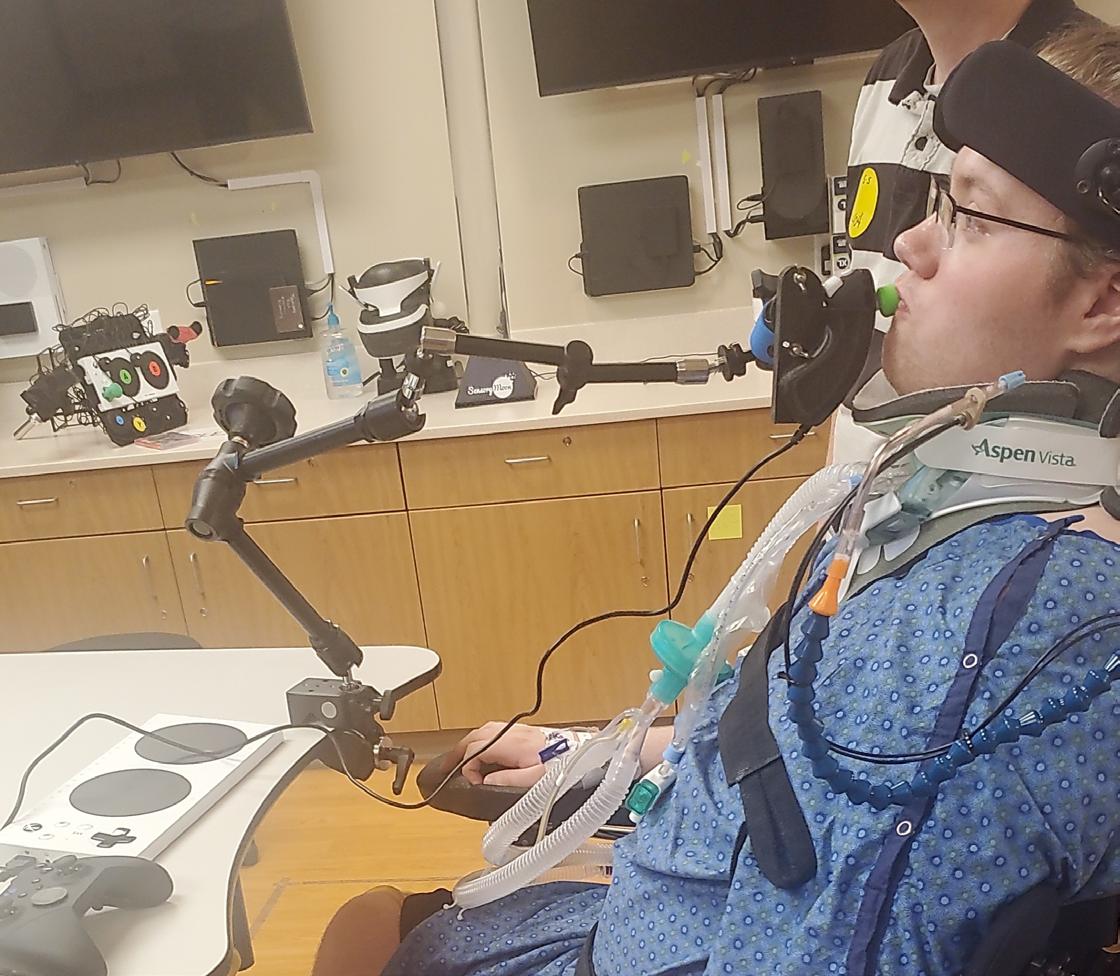

In January 2020, the Journal of Neurologic Physical Therapy published an article maintaining that clinicians should provide a walking program to patients with brain injury and incomplete spinal cord injury six months after injury.
But the research team at Craig wanted to understand why patients couldn’t start a walking program prior to six months.
“There are no large studies examining high-intensity step training earlier than six months post-traumatic brain injury, so we decided to embark on a study that explored the efficacy and safety of high-intensity step training to improve balance and mobility after traumatic brain injury,” explains Haylee Winden, a clinical research physical therapist at Craig.
Enter the “High Intensity Step Training After Traumatic Brain Injury” study, which evaluates three therapeutic approaches to improve mobility and balance after a traumatic brain injurty (TBI): conventional gait and balance training, high intensity step training, and high intensity step training with virtual reality.
“The study explores whether the types and intensity of interventions correlate with improvement in mobility, balance and cognition,” Haylee says. “The long-term goal of this study, which began in March 2023 and concludes in August 2027, is to be able to help patients get better faster.”
She adds, “The current physical therapy clinical practice guidelines for walking interventions six months post TBI was published in 2020. Due to the lack of research, clinicians have previously expressed concerns over the safety of significantly increasing one’s heart rate so close to injury. We hope to challenge this belief and look forward to our results. Currently, there are 47 patients enrolled in the study, and we need a total of 99 to complete our data set in 2027.”
This study is a great example of Craig’s investment in accelerating innovation through translational research breakthroughs. In support of innovation, the Craig Foundation is raising funds to build a state-ofthe-art Human Movement Lab — an 8,000-squarefoot living laboratory designed to provide real-time feedback and translate research findings quickly.
For more information on the study, or to learn more about participating in research, scan the QR code or visit craighospital.org/research/studies


In collaboration with the University of Colorado Boulder Department of Integrative Physiology and Clinical Translational Research Center, Dr. Andrew Park and his mentors were recently awarded a Career Development Grant from the American Heart Association.
This award will support Dr. Park—a spinal cord injury physician and researcher—to continue to advance research that helps prevent heart attacks and strokes in people with spinal cord injury.
Recent studies have demonstrated that adults with spinal cord injury sustain heart attacks and strokes much earlier in life. People with spinal cord injuries develop plaque in vessels much faster, but the mechanisms of why are unclear.
Physicians used to think that plaque formed because people with spinal cord injuries gained weight and developed diabetes. However, many studies have shown that even without these common risks, plaque in the vessels develops more often and faster.
Endothelial cells, a single layer of cells that line all vessels in the body, play an important role in vessel health. Damage to endothelial cells is known to lead to heart attacks and strokes, but it is unclear if endothelial cells of people with spinal cord injury are healthy.
“Our research team has new data showing that these cells are unhealthy after spinal cord injury, using a more accurate measure of endothelial health,” Dr. Park says. “We are also characterizing small particles that we can measure in the blood, which may be a better marker of the health of these endothelial cells. If our project is successful, we will learn a lot about the health of endothelial cells after spinal cord injury.”
He adds, “We will also be able to use our marker of endothelial cell function to create treatments to improve vessel health and prevent heart attacks and strokes later in life in people with spinal cord injuries.”
Since 2020, Dr. Park has been part of the CNS Physician Group and Craig Research Department teams. He knew early on in his education that he wanted to focus on SCI rehabilitation, and he came to Craig already deeply invested in treating SCI patients and furthering their long-term successes.
“I grew up in a time when exciting new research was coming out that was disproving the idea that neurological injury, specifically SCI, is something that’s not curable and something that we can’t improve,” he says. “When I actually got to work with patients with spinal cord injury throughout my training, I also saw how providers get to have these longitudinal relationships with people and their families to continue on with their life. That’s what really attracted me to SCI.”
Today, Dr. Park splits his time between Craig’s dual focuses of research and neurorehabilitation, which allows him to provide important insights into both areas of care.
“The way we think about problems and the way we think of solutions to those problems in research and clinical work are often very different,” Dr. Park explains. “I’m hoping my research will be more translational and be able to bridge that gap where I’m studying things that I can apply to my patients and then questions that come up in the clinic I can apply to research.”

On a cold, rainy night in the fall of 1982, Larry Lavelle was involved in a serious car accident. He spent three months in a hospital near his Pittsburgh home before transferring via Angel Flight to Craig Hospital.
While Larry recovered in Denver with his wife, Nancy, by his side, his four young children were back home in Pittsburgh.
Thanks to the generosity of their community, the children were able to visit their dad in Denver once. Mark, Larry’s son recalls, “Craig staff treated us all like family, while my dad recovered and my mom focused on learning the caregiving skills needed for life after Craig. We felt so grateful for the Craig community, who was there for us when we most needed the support.”
This gratitude inspired the Lavelle Family Foundation to give back to Craig with a $1,000,000 challenge gift, encouraging others to get involved in philanthropy!
“The impact that Craig had on our lives inspired this gift. It’s our story,” Mark explains. “It was a story born out of tragedy, but it turned into a story of great hope, joy, and perseverance. We wanted to give back, and our hearts led right to Craig.”
When Larry first arrived at Craig, he had a C2-C3 incomplete spinal cord injury. He was on a respirator and couldn’t move any of his extremities.
“But the Craig team taught him so much, including how to breathe, which meant not only could he do a lot more physically, but his life expectancy was longer. Craig gave him the confidence to go home and face life. He was interested in looking to the future, thanks to the positivity he learned at Craig. He started to believe in a next chapter.”
Adds Mark, “My family thinks of this gift as a privilege and an honor. It feels like so much more than just giving. There’s no word for it—except gratefulness.”
Click or scan to join the challenge with us!
The American Academy of Neurology has selected the abstract, “Transcutaneous Spinal Cord Stimulation (ARC-EX Therapy) is Safe and Effective at Improving Upper Extremity Function Following Spinal Cord Injury,” for the merit of distinction in 2024.
This research on ARC-EX Therapy, led by Candy Tefertiller, PT, DPT, PhD, NCS, Craig Hospital’s Executive Director of Research and Evaluation, and the Helen Phillips Levin Endowed Chair of Research, was chosen based on the quality of the study and interest to the neurologic community.
“The SCI community is eager to have access to this innovative technology,” Dr. Tefertiller explains. “Even a small difference in hand and arm function can have a profound impact on independence and quality of life. The results of the Up-LIFT trial that led to this submission represent a significant advancement in the use of neuro-modulation for individuals with spinal cord injury.”
The Up-LIFT trial—which enrolled 65 individuals across 14 sites with chronic quadriplegia—demonstrated improvements in upper extremity function and strength in response to training in combination with transcutaneous spinal cord stimulation. This stimulation is a non-invasive form of neuromodulation in which electrodes are placed on the skin and used to stimulate the spinal circuitries via an electrical current.
In addition, 17 individuals were able to use the spinal stimulators in their homes for one month and demonstrated continued improvement in some of the outcomes. Most importantly, the home portion of the study demonstrated individuals were able to safely use the devices in their homes with caregiver support. Craig enrolled more participants in these two trials than any other center.

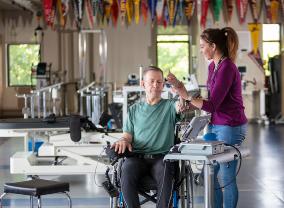
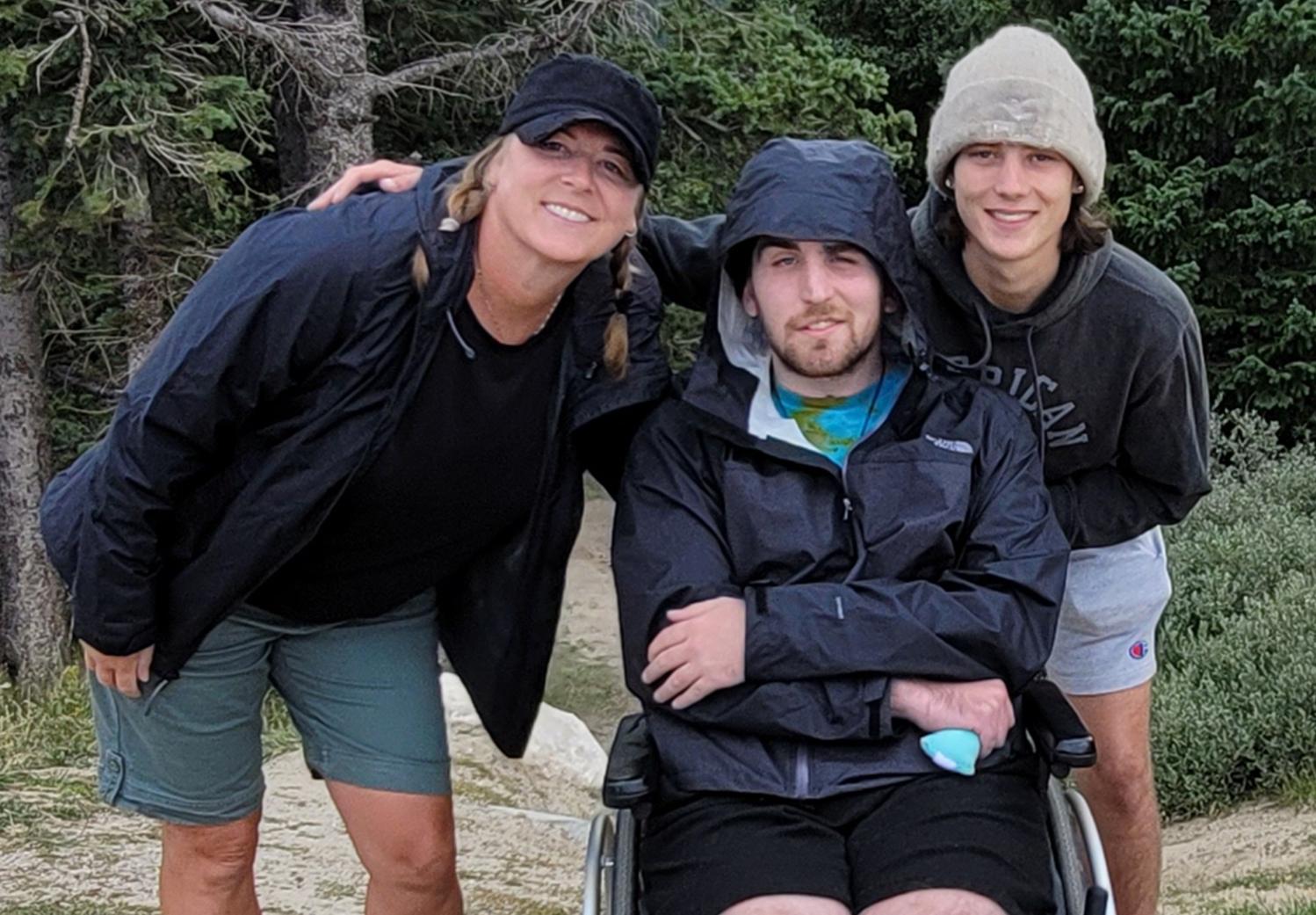
About three years after 18-year-old Thomas McLaurin sustained a diffuse axonal brain injury in a car accident, he and his family attended Craig Hospital’s 2023 Adventure Program trip in Breckenridge, Colorado.
“The trip was absolutely amazing,” recalls Thomas’s mother, Megan. “It gave us hope that we could all live a normal life once again.”
While in Breckenridge, Thomas—along with three other teenage boys and their families—spent several days kayaking, rafting and zip lining and enjoyed a ropes course, yoga and game nights.
“Originally, I was hesitant to take Thomas on the trip because he has become very introverted since the accident. I was worried that he’d feel overwhelmed and want to stay in his room the entire weekend,” Megan says. “But I decided to push Thomas and his younger brother, Connor, to go to prove that we can still live life.”
She adds, “Thanks to our experience at the Breckenridge Outdoor Education Center, we all gained confidence in living more, taking on adventures, and stepping out of our comfort zone. I am not sure I have felt like myself since the accident— constantly living in fear of the what-ifs—but once I saw Thomas enjoying himself, I felt a huge weight lift. I could finally relax.”
Even Thomas was shocked that he could participate in every activity. “I was not interested in going because I didn’t think I could take part in the planned activities, like white water rafting and ziplining,” he says. “But I did take part—and it was really cool seeing the other guys do it, too. My favorite activity was playing Uno and sitting around the fire while everyone sang songs. I hope to go back again and see my bros.”
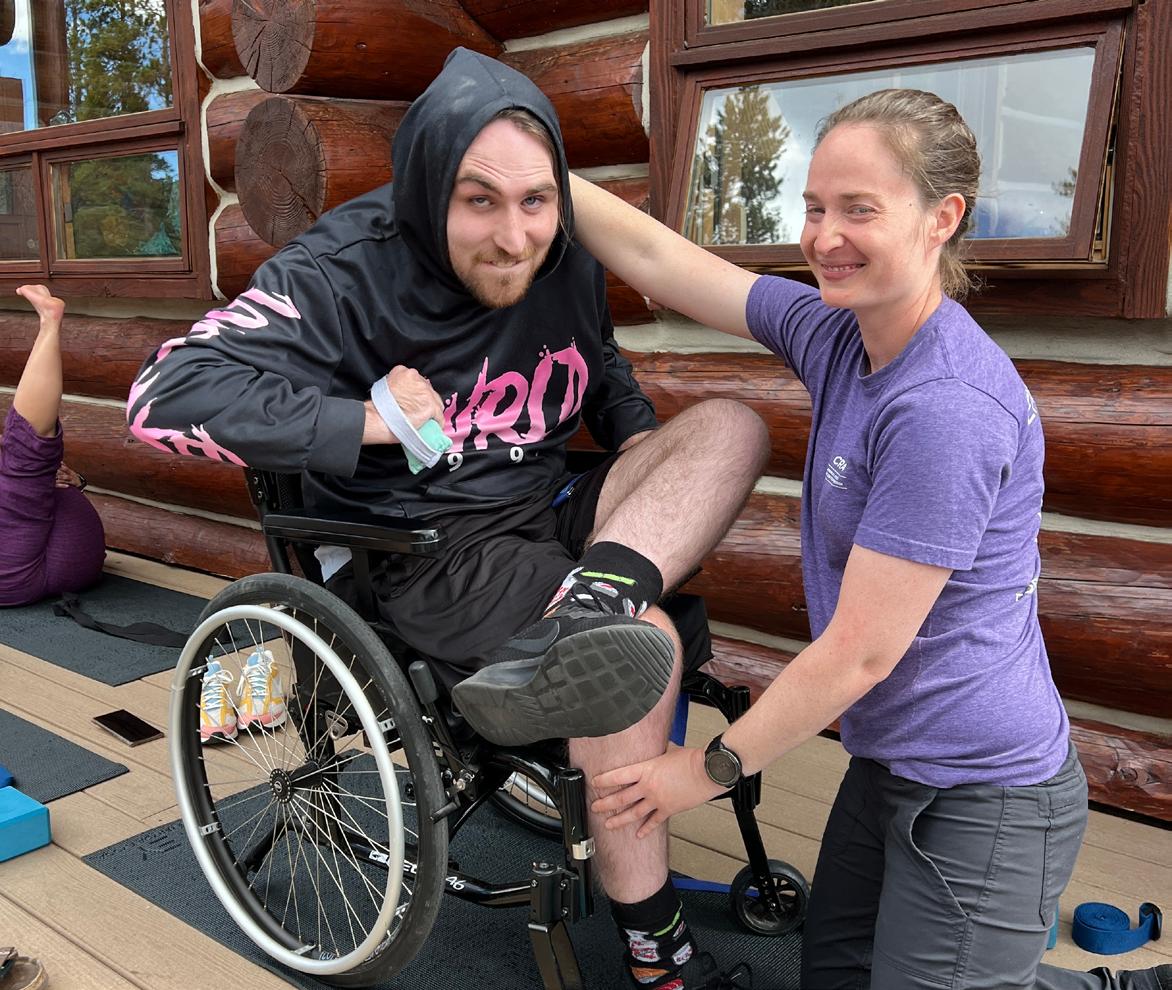

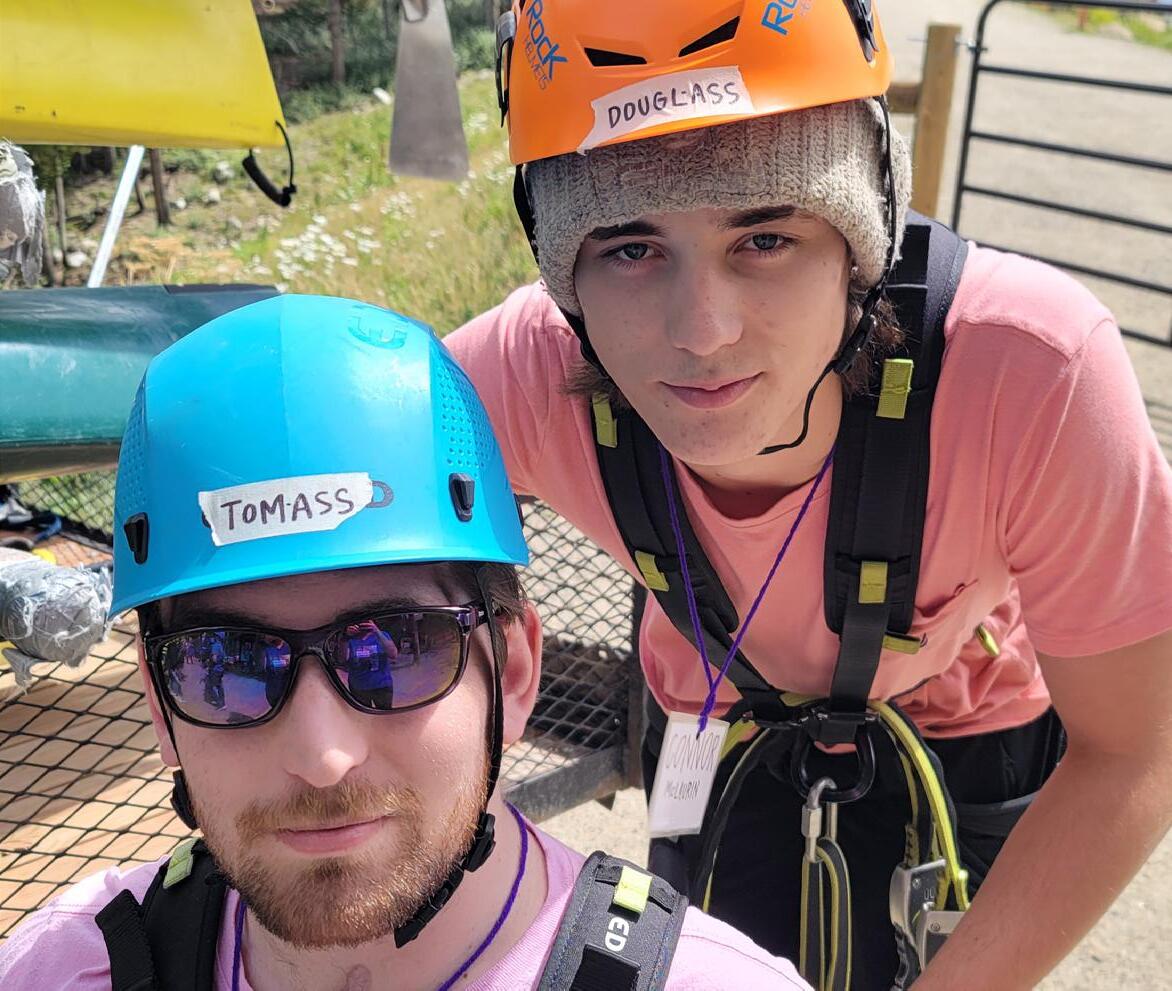
An accomplished soccer player who was planning to play soccer in college, Thomas decided to take online classes at Metropolitan State University of Denver during the fall of 2020 due to the COVID-19 pandemic.
Shortly after the fall semester began, an undiagnosed heart condition caused Thomas to faint while driving, leading to a single car accident that ejected him from the vehicle at 55 miles per hour.
Thomas spent the next three months in the hospital before being transferred to Craig. “He wasn’t really awake when we arrived at Craig, but thanks to everything they offer—including physical therapy, occupational therapy, speech therapy, music and aquatic therapy, therapeutic recreation, and adaptive gaming—he slowly began to improve,” Megan recalls.
While at Craig, Megan learned the importance of family participation.
“When you actively participate, you learn how to help your loved ones,” Megan says. “Because Craig has so much expertise, I took advantage of everything they could teach me. As Thomas’s caregiver, I had to learn how to advocate for him and take care of his needs. I knew I had to embrace all that Craig had to teach me before Thomas came home.”
She adds, “Every day, I felt blessed to be at Craig, the number one hospital for Thomas’s injury.”
After Thomas’s doctors originally predicted the worst, he is back at home, continuing to work on his recovery.
“Thomas doesn’t spend a lot of time talking about the future, but instead chooses to live one day at a time,” Megan explains. “As a soccer enthusiast since the age of three, he knows he can no longer play his favorite sport, but he hopes to coach someday.”
She adds, “Motivation can be challenging for individuals with a brain injury, so we just take it slow. We choose to feel thankful for the progress that he’s making—and for everything that Craig has given us.”
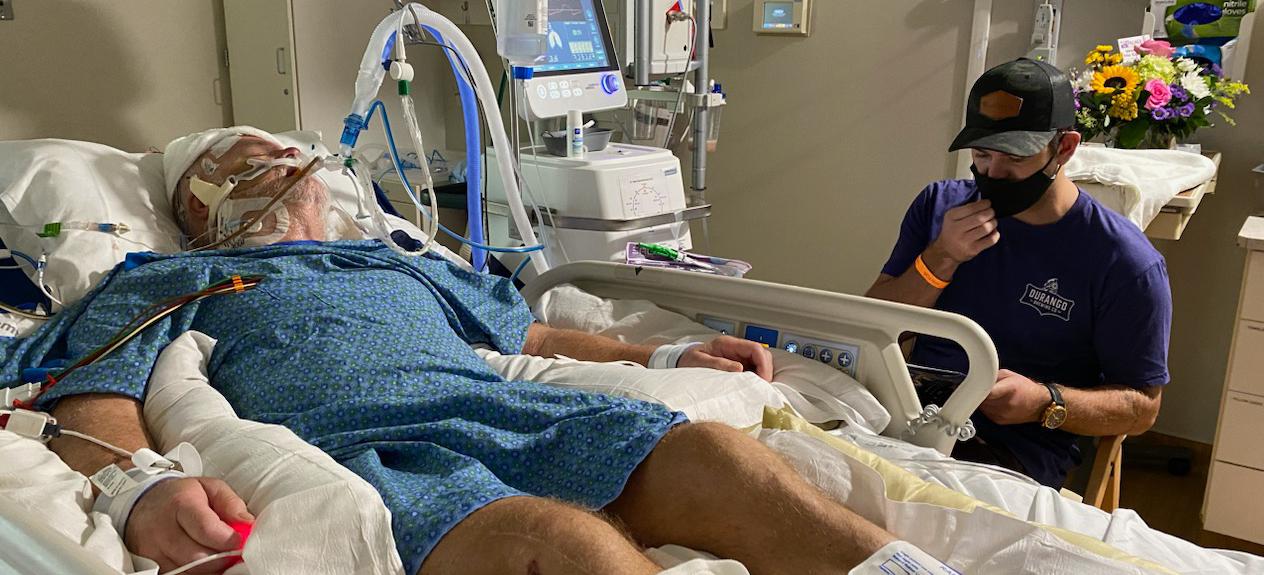
On Saturday, April 14, 2021, 62-year-old Terry Rudd completed the Stonewall Century Bike Ride in south central Colorado. For 102 miles, Terry followed Highway 12, a Colorado Scenic Byway, with grades exceeding 10 percent and a steep climb to the top of 9,995-foot Cuchara Pass.
Less than one month later, Terry, a lifelong cyclist, was out for a light training ride near his home in Fort Collins when he threw a blood clot in his lower left leg. The clot quickly traveled up to his left ventricle and caused a sudden heart attack.
Terry fell to the pavement where an out-of-state paramedic spotted him and pulled over to help. A few minutes later, a nurse from a nearby hospital also stopped to assist.
“They switched on and off, applying CPR as they waited for the ambulance to arrive,” Terry says. “Their efforts kept me alive until the ambulance arrived and took me to the hospital for emergency heart surgery.”
There, surgeons installed a stent, and Terry exited the surgery on a ventilator in critical condition. Doctors gave him less than a two percent chance of survival. After a week, they were preparing to remove life support to allow Terry a natural death, when he suddenly woke up. “To everyone’s astonishment, I opened my eyes and asked what had happened. From there, I headed directly to recovery.”
Terry spent the next four weeks in the hospital. A very fit long-distance cyclist, he found that mending his heart was not his biggest problem. Rather, recovering his brain would be a long-term challenge.
After being discharged, Terry headed to Craig Hospital for one month of inpatient therapy and five months of outpatient therapy. “Those first few weeks at Craig were some of my best days and some of my worst days,” Terry recalls. “While I loved and respected my care team immensely for their compassion and patience, I experienced days of great sadness and despair due to my condition and slow progress.”
He adds, “One night after my first week at Craig, my mind was full of very dark thoughts as I prepared myself to die. I was in a deep depression and didn’t know how to ask for help. Fortunately, I realized that I was being extremely selfish and not thinking about everyone who was working so hard to help me. I was alive, and I needed to be thankful.”
Terry credits Dr. Jim Berry, a Craig Hospital rehabilitation neuropsychologist, for guiding him during that dark time. “Dr. Berry worked with me to understand that my feelings were ‘normal’ for brain injury patients,” Terry says. “He helped me talk about my emotions and learn management techniques to prevent overwhelming thoughts. There is no question that he was invaluable to my wife and me during my recovery. I am forever grateful for his expertise.”
While at Craig, Terry spent long days working to heal his brain and body: “I learned how to deal with my brain injury, including my poor balance and muscle atrophy. I also worked on re-learning personal care, meal preparation and daily living skills. And I spent a lot of time with Wendy Gordan,
my speech pathologist, working on improving my communication, critical thinking and response capabilities. The team worked me hard, but I enjoyed seeing progress. I felt myself getting happy once again.”
He took part in the Therapeutic Recreation Program, practicing balance skills at Red Rocks Park and at Craig’s PEAK Center. He also enjoyed spending time with other patients, offering motivation and encouragement to those around him.
Being able to drive again was extremely important to Terry, so he spent a great deal of time in Craig’s donor-supported Driving and Adaptive Transportation Program. He practiced on the hospital’s driving simulator—a computerized driving simulation used to highlight areas of strength and identify areas of driving risk–and took part in onthe-road evaluations—driving sessions to assess performance and evaluate driving risk related to injury or medical condition.
“I worked with my occupational therapist, Lenora Henderson, on reaction testing and learned exercises to optimize response times to prepare myself for unexpected events on the road,” Terry explains. “I also practiced driving with Craig’s driving instructors so I could pass the DMV’s drive test and resume driving back in Fort Collins.”
Helping patients return home and achieve independence is one of Craig Hospital’s goals. “People need to be able to access their community and return to work if they are able. Re-engaging with life will only help their recovery,” explains Barry Doyle, adaptive transportation supervisor at Craig. “We typically begin driving with patients in a parking lot, then move to neighborhood roads, twolane roads, and eventually, the highway. We also review the rules of the road and look for consistency behind the wheel. It’s important to help patients regain confidence and facilitate a medical clearance with the DMV.”
In addition to driving, Terry was determined to return to work. “As a software engineering manager at Canonical Ltd., I had hoped to return to work as soon as I was released from Craig’s inpatient program.”
However, regular sessions with Dr. Berry helped Terry realize that going back to his previous job was not a reality for him.
“The truth was that I had several limitations and could no longer keep up with my demanding job,” he explains. “It was one of the hardest decisions I have ever made, but Dr. Berry helped me through it. Not only did my wife want me to retire, but I needed to come to terms with my poor short-term memory, as well as my diminished processing and my difficulty handling interruptions.”
Terry is now back to driving his car, although he insists that he’s a more cautious driver. He’s also back on his bike. “A lack of balance was my initial concern, but I re-skilled myself to figure out how to ride safely,” he explains. “Today, I am more mindful about what’s going on around me. I don’t take any risks when I’m on my bike.”
An avid woodworker, he is looking forward to returning to his hobby. He also spends time reading, taking long walks, working out in his home gym, and spending time with friends and family. Traveling and volunteering in the community are also on his to-do list.
“I learned so much from this experience,” Terry says. “It’s important to have patience with yourself and give yourself a lot of grace. When you sustain a brain injury, you need to accept the new you and allow yourself to learn new coping skills. You must constantly challenge your brain by working at it. You must push yourself and most importantly, never ever give up.”


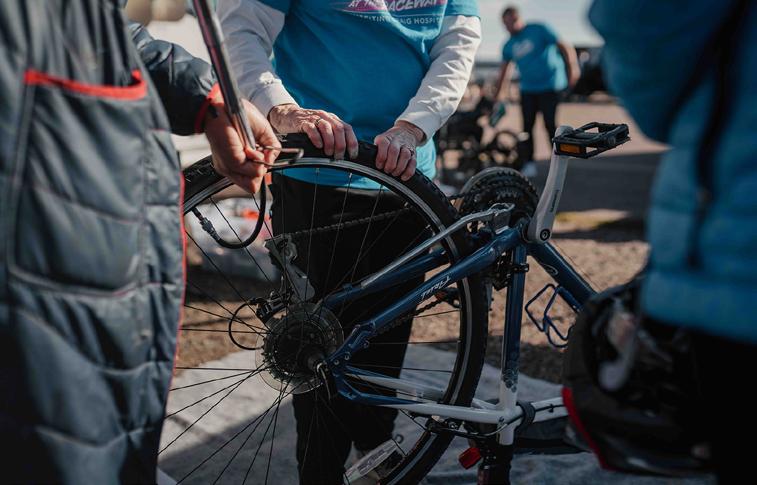
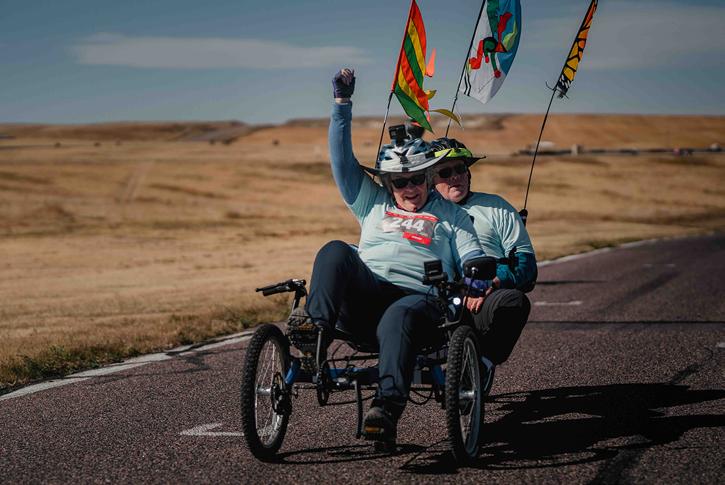

High Plains Raceway is set to host the muchanticipated Pedal 4 Possible event on Oct. 26, and Craig Hospital’s Therapeutic Recreation department is gearing up to ensure Craig graduates and adaptive riders have a bike that fits their needs perfectly.
In partnership with Adaptive Adventures, Therapeutic Recreation provides custom-fitted adaptable bikes at no cost, making the event accessible for inpatients, Craig graduates, and community members. This initiative ensures a smooth and enjoyable ride for all participants.
The week before the event, participants will schedule individual fitting sessions where padding, pedal adjustments, and other customizations are made to tailor the bike to the rider’s needs.
Therapeutic Recreation’s Kelly Secor plays a crucial role in matching riders with the appropriate cycles, ensuring each fit is perfect to prevent pressure sores and other injuries. Handcycles, recumbent cycles, and
tandem cycles are offered for adaptive riders, allowing everyone to participate safely in Pedal 4 Possible.
On the day of the ride, the Therapeutic Recreation and Adaptive Adventure teams handle the logistics of transporting the bikes to the raceway, eliminating any burden on the riders. Thanks to these thorough preparations, participants can simply hop on and start their journey without the need for any adjustments.
This commitment to inclusivity, safety, and the sheer enjoyment of cycling ensures every rider can fully participate and have a memorable and empowering experience.
P4P is Proudly Sponsored By:










